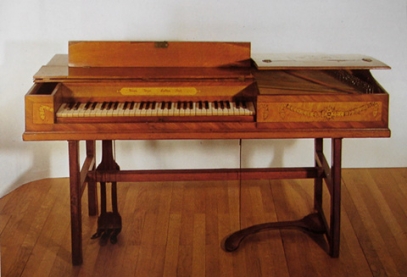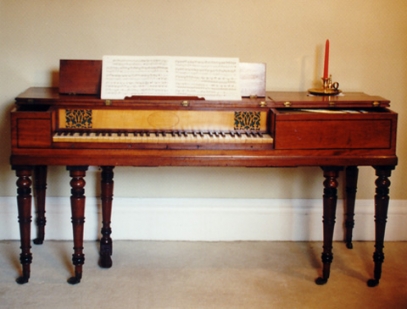English square pianos

Some initial signs for a shift from harpsichord to piano could be noticed in England from about 1765 to 1785, a first chapter of the piano success story. During the Seven years' war the Saxon instrument maker Johannes Zumpe emigrated to London and started producing square pianos. In England the clavichord never had had a significant importance and a small keyboard instrument capable of dynamic playing was a sensational novelty. In 1764 at the first time a piano was played in a public concert by none other than Zumpe's Saxon compatriot Johann Christian Bach – not an impressive grand but a small square.
Zumpe's squares sold like the proverbial hot cakes and his success attracted more immigrants like the Saxons Johannes Pohlmann and Adam Beyer (Abb. 1), the brothers Astor from Walldorf in the Palatinate or the Italian virtuoso Muzio Clementi. Piano workshops within a few decades grew into the first music shops producing (or rather: trading with) all sorts of musical instruments, importing and exporting, printing and trading with musical scores, arranging concerts. Firms like Longman & Broderip (later Clementi & Co.), Astor & Co., Collard & Collard or Gerock & Wolf thus established the modern music industry in London around 1800.
The enormous economic prosperity was founded on the success of the square piano (and a few more almost forgotten fashion instruments like the „English Guitar“ ). Like in the previous centuries with the traditional English domestic keyboard, the virginal, the gentry and rich citizenry formed a class of buyers not existent in other European countries at that range, a group which showed an interest in musical education too. The ideal of a well educated "gentleman
amateur“ without professional ambitions, shound should cope with a violin or flute and have a pleasant voice, a well mannered proper "lady“ should sing nicely and play a piano, thus accompaning each other suitably. For such requirements an instrument was needed that was a chamber music instrument in true sense, its volume not overpowering a maybe just tender or shy voice but by all means giving a decorative and tasteful appearance in a drawing room or salon.

Although square pianos were slowly growing bigger and more powerful in sound (Abb.2), against this background something not existing in other countries originated: the piano as an important design task for carpenters, sculptors, painters, architects. The row of famous English artist working for the Broadwood firm alone, designing pianos, from the 1790s to the 20th century began with Sheraton and Chippendale jun., later Edward Burne-Jones, Lawrence Alma
Tadema and William Morris to Baillie Scott and Edward Lutyens. Many details of single prototypes were included into serial models to decorate a manor house or representative home.
P. S.: The younger brother Astor soon moved on from London to New York and his birthplace as well as family name grew to legend as well as his wealth; but no longer acquired by trading with square pianos (which he initially did though). But that's is a completely different story ...
© Greifenberger Institut für Musikinstrumentenkunde | info@greifenberger-institut.de



